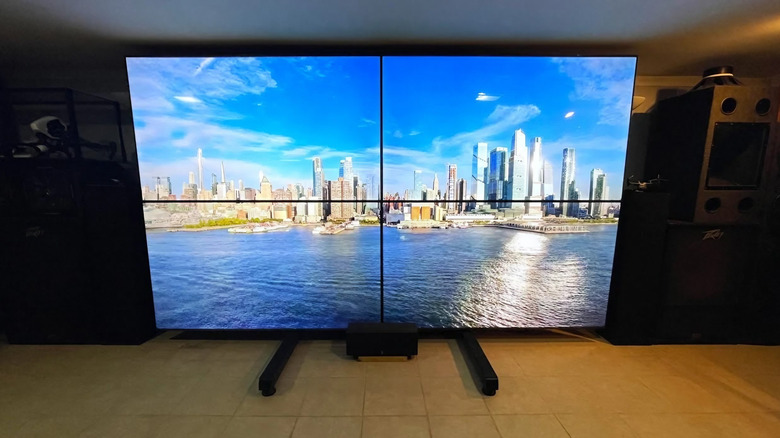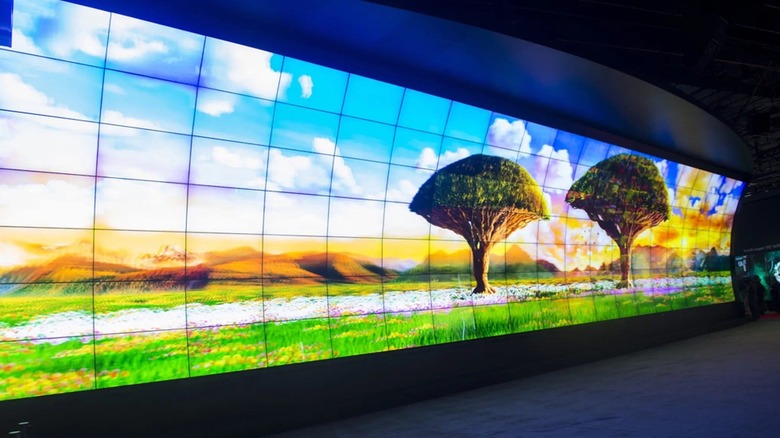How To Connect Four TVs And Make One Massive Screen
Connecting four TVs to create one massive screen might sound like overkill, but it's a surprisingly practical way to get a jaw-dropping, ultra-immersive display at home. A setup done right can be like turning your living room into the control center of NASA or the ultimate gaming lair. Traditionally found in airports, boardrooms, and sports bars, "video walls" have recently made their way into homes thanks to cheaper prices and easier setups.
In such a setup, each screen (usually a commercial-grade LED or LCD panel) acts like a tile, displaying part of the full image. When arranged and calibrated correctly, they come together to present one seamless, high-resolution picture that looks just like a giant TV. Such setups can be particularly great for binge-watching movies, throwing a Super Bowl party, or playing split-screen video games. Let's dive into the nitty-gritty details of the gear you'll need to design a clean setup and get the most out of your video wall.
The essential components you need to build one
To create a four-TV video wall that behaves like a single giant screen, you'll need four ultra-thin bezel 4K displays and a whole lot of other gear. For TVs, models like the LG UR9000 or Samsung QN90C are solid bets for performance and visual uniformity. Then comes the media player (or video wall controller), which takes one content source and splits it intelligently across all four screens. One reliable option is the Datapath Fx4. These crucial devices allow for real-time synchronization and precise alignment of your content. Some controllers even offer flexible layouts so you're not stuck in a rigid grid if you ever want to shake things up.
You'll also need mounting brackets designed for grid alignment. Vivo (not the smartphone brand) and Peerless-AV make sturdy, tiltable mounts that simplify installation. Then, a good HDMI splitter (like the J-Tech Digital 4K 1x4) or matrix switcher will help distribute the video signal evenly if you're working with less advanced controllers. Finally, the glue that ties everything together is the video wall software. Options like CrownTV or Wallboard CMS let you upload, schedule, and push content seamlessly from your laptop or cloud dashboard. Altogether, expect the full setup to cost between $3,500 and $6,000, depending on the gear you choose. That said, if you're looking to connect multiple monitors instead, our guide on how to daisy-chain them will help.
How to install and get the most from your setup
Once you've got your TVs, controller, and mounts ready, it's time to piece everything together. Start by measuring your wall space and TV with laser precision. A 2x2 grid with four 55-inch TVs should need at least a 100-by-60-inch surface area, plus buffer room. Use a level, a stud finder, and painter's tape to mark out exact mounting points. Check out the detailed video by Xpress TV Mounting above for a clearer look.
After marking your layout, securely install the mounts, ideally anchoring them to studs for maximum support. Once all four brackets are up and aligned, lift the TVs into place. This is a two-person job, minimum, so don't wing it solo unless you like broken panels. With the displays mounted, connect them to your video wall controller using high-speed HDMI or DisplayPort (DP) cables. The controller should already be pre-configured for your layout, but if not, most platforms include quick setup wizards. When your displays are connected, power everything on and launch your video wall software. Align the image across your screens using the controller's calibration tools to eliminate bezel bleed or sizing mismatches.
Pro tip: Give your setup space to breathe since these displays can run hot. Consider adding a small fan or keeping the AC on low nearby during long runtime sessions. Lastly, when you're not watching anything, you can feed your video wall with slideshows that look good blown up.

